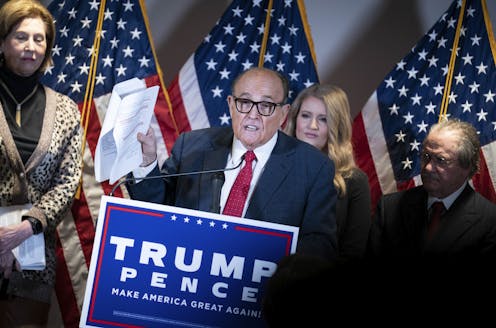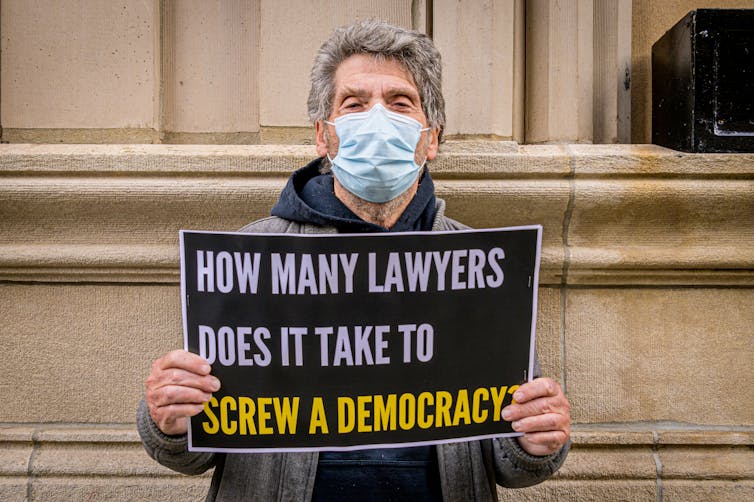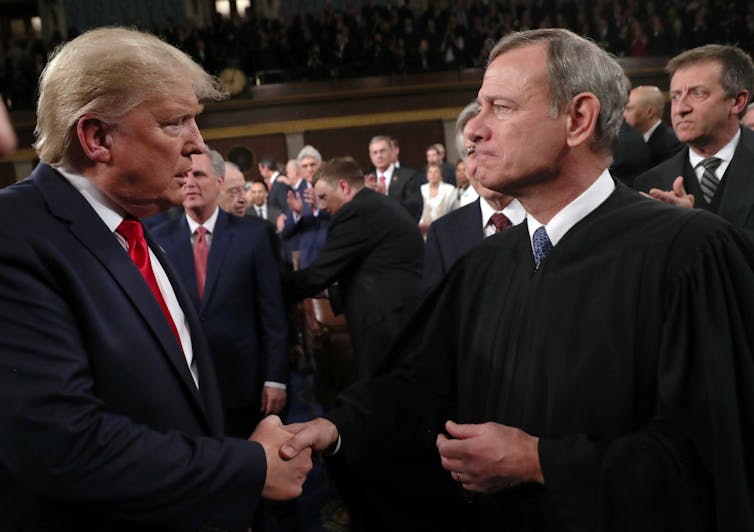In Trump election fraud cases, federal judges upheld the rule of law – but that's not enough to fix
President Trump's populist control of his party didn't extend to control in courtrooms where he challenged election results. That's where the rules of politics met the rules of law, and politics lost.

A healthy constitutional culture, in which the people and their leaders respect the authority of their Constitution, requires a baseline of trust in the government – a baseline that, in the United States, has eroded from 77% in the early 1960s to 17% today.
This collapse of public confidence paved the way for a populist form of leadership that redirected public faith away from the institutions of government toward a more autocratic leader – Donald Trump – whom voters trusted to consolidate power, neutralize opposition and “drain the swamp” of the experts and bureaucrats he deemed responsible for the government’s malaise.
In the past four years, President Trump has consolidated power to such an extent that the Republican Party has literally declined to adopt a party platform and effectively embraced the president as its alter ego.
After losing the 2020 election by a comfortable margin,
Trump counted on the populist power he had accumulated to force the hands of Republican officials across the country to invalidate the election, despite no creditable evidence of widespread fraud.
The gambit almost worked. Trump’s influence – made muscular by an energetic base poised to punish disobedient elected officials – quieted intraparty criticism, moved a legal team to launch a battery of meritless lawsuits and inspired 18 state attorneys general to request that the Supreme Court overturn a presidential election.
But that strategy ultimately failed, because Trump’s populist control did not extend to the federal courts.

Cases need facts
The legal assault on the election was spearheaded by attorneys who were willing to file suits based on unsupported suspicions and beliefs to perpetuate the president’s populist regime by any means necessary. These groundless suspicions and beliefs – bellowed loudly and often by the president and his entourage – may have gotten traction in politics, but they got none in courts of law. The judiciary’s firewall withstood the populist bomb that President Trump detonated.
Apart from the fact that neither the president nor his enthusiasts could threaten the tenure of unelected federal judges who are appointed for life, judges are a different kind of public official, and the lies, bullying and bombast that work well in populist politics fall flat in courts of law.
When judges hear cases, they follow a uniform system of procedural rules that enable them to evaluate the claims that the parties make and amass a body of information on which they rely to determine facts and ascertain truth. It’s a system that has served the judiciary well for generations, and served it well in the postelection cases that the courts decided in recent weeks.
Judges are lawyers who have been steeped in the rule of law for decades. It begins with three years of law school, where they “learn to think like lawyers” and are graded on their command of substantive and procedural law. Upon graduation, they must demonstrate their proficiency in law by passing a bar exam, and then practice law for years and typically decades before ascending the bench.
‘Trump judges’ aren’t Trump judges
Trump has been criticized for appointing an unprecedented 10 judges whose credentials and experience the American Bar Association deemed so deficient as to warrant an “unqualified” rating. But the vast majority of his 227 appointees possess the traditional qualifications needed to perpetuate the federal judiciary’s entrenched commitment to the rule of law.
Some of the judges who dismissed the Trump election cases were appointed by the president. That may have shocked Trump and his followers, but is unlikely to have surprised Chief Justice John Roberts. In 2018, Roberts called out Trump for attacking “Obama judges.”
“We do not have Obama judges or Trump judges, Bush judges or Clinton judges,” Roberts said in a statement. “What we have is an extraordinary group of dedicated judges doing their level best to do equal right to those appearing before them. That independent judiciary is something we should all be thankful for.”
Some criticized Roberts as naïve or duplicitous. After all, the data show that federal judges are influenced by their ideological preferences. Voters know this and choose a president who will appoint ideologically compatible judges.
These critics, however, miss the mark. Yes, judges are subject to ideological influences in close cases, when the law is subject to conflicting interpretations, and judges tend to favor interpretations that align with their common sense and policy perspective.
But this does not refute Roberts’ point: Federal judges are trained to take law seriously and do their best to uphold the law as they understand it to be written. So when confronted with postelection fraud cases that were not close – that lacked factual allegations essential to proceeding with the case – judges ruled against the president.
As one judge said to Trump campaign lawyers, “Come on now!”

Facts and truth
Thanks to those judges, the rule of law held firm against a populist assault.
Celebrating the triumph of the rule of law in the courts, however, obscures the reality that innumerable voters, public officials and lawyers who were ostensibly committed to that rule of law stood ready – for the first time in U.S. history – to overturn a presidential election.
In the past, the majority of Americans drew their conclusions from a common body of information received from the same evening news and morning newspapers.
With the explosion of the information age and the decline of traditional media, that common body of information has disappeared, as the marketplace of ideas has been flooded with limitless information, the truth or falsity of which is increasingly difficult to assess. The consequences are voiced by a nihilistic spy in the latest “Call of Duty” video game: “There is no truth – only who you choose to believe.” And this, it would seem, has become the mantra for many public officials and their constituents.
Americans encountered a similar problem once before, during industrialization, when the nation was deluged with a flood of false and misleading information about new drugs, foods and consumer products – a problem that the administrative state ultimately emerged to regulate.
The trouble is that the government can’t regulate the marketplace of ideas the way it does the marketplace of goods and services – the First Amendment won’t allow it. In most cases, the government cannot prohibit you, media outlets or politicians from telling lies.
So the challenge is to reestablish a way to evaluate the reliability of information upon which we must depend for finding facts and ascertaining truth. Because if that can’t be done, the nation’s ability to elect its leaders and govern itself in an orderly and principled way will be lost.
The Constitution is fragile. It works because we the people will it to work, and that will is being tested, perhaps as never before. The judiciary passed its latest test. The American people will be tested again in the years to come – and the future of the democracy hangs in the balance.
Charles Gardner Geyh does not work for, consult, own shares in or receive funding from any company or organization that would benefit from this article, and has disclosed no relevant affiliations beyond their academic appointment.
Read These Next
Chile elects most right-wing leader since Pinochet – in line with regional drift, domestic tendency
José Antonio Kast, who has run for the presidency several times, successfully seized on widespread…
Epstein’s victims deserve more attention than his ‘client list’
Powerful men connected to Jeffrey Epstein are named, dissected and speculated about. The survivors,…
The ‘one chatbot per child’ model for AI in classrooms conflicts with what research shows: Learning
AI tutors are often held up as an ideal, but prioritizing individualized teaching can detract from the…






